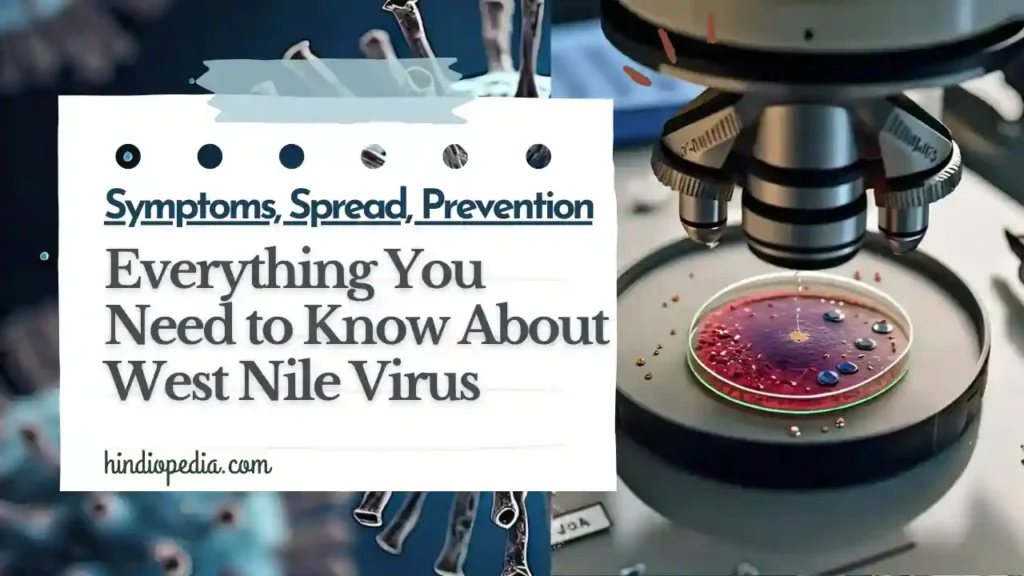Understanding West Nile Virus: Transmission, Symptoms, and Prevention
West Nile Virus (WNV) is a mosquito-borne flavivirus primarily affecting birds but can infect humans. Spread by Culex mosquitoes, WNV causes mild symptoms like fever and severe symptoms like paralysis in rare cases. Prevention includes using insect repellent and eliminating standing water. No specific treatment exists; supportive care is essential. Research focuses on vaccines and control methods.

West Nile Virus (WNV) is a mosquito-borne virus. It primarily affects birds but can infect humans and other animals. First identified in Uganda in 1937, it has since spread worldwide. Understanding WNV is crucial for public health.
What is West Nile Virus?
West Nile Virus is a flavivirus. Flaviviruses are a group of viruses that include Zika and dengue. WNV is mainly transmitted by mosquitoes. When a mosquito bites an infected bird, it can pick up the virus. The mosquito can then transmit the virus to humans and other animals.
How Does West Nile Virus Spread?
WNV spreads through mosquito bites. The primary vectors are Culex mosquitoes. These mosquitoes are common in many parts of the world. Birds are the main reservoir hosts. This means they carry the virus without getting sick. Humans and horses are considered incidental hosts. They get infected but do not contribute to spreading the virus further.
Symptoms of West Nile Virus
Most people infected with WNV do not show symptoms. About 80% of infected individuals are asymptomatic. For those who do develop symptoms, they fall into two categories:
Mild Symptoms (West Nile Fever):
- Fever
- Headache
- Body aches
- Skin rash
- Swollen lymph glands
Severe Symptoms (Neuroinvasive Disease):
- High fever
- Neck stiffness
- Stupor
- Disorientation
- Coma
- Tremors
- Convulsions
- Muscle weakness
- Paralysis
Severe symptoms are rare. They occur in less than 1% of cases. Older adults and people with weakened immune systems are at higher risk for severe disease.
Diagnosis and Treatment
Diagnosis of WNV is through laboratory tests. Blood tests can detect antibodies against the virus. In severe cases, cerebrospinal fluid (CSF) may be tested.
There is no specific treatment for WNV. Care is supportive. This means treating symptoms as they arise. Pain relievers can help with headaches and muscle pain. Severe cases may require hospitalization.
Prevention and Control
Preventing mosquito bites is key to avoiding WNV. Here are some effective measures:
- Use insect repellent containing DEET or picaridin.
- Wear long sleeves and pants, especially at dawn and dusk.
- Ensure window and door screens are intact.
- Eliminate standing water around your home. Mosquitoes breed in stagnant water.
Community efforts are also vital. These include mosquito control programs and public education campaigns.
Interesting Facts About West Nile Virus
- Birds as Sentinels: Birds are often monitored to detect WNV presence. Dead bird reports can help track the virus spread.
- Climate Impact: Climate change affects mosquito populations. Warmer temperatures can expand the range of Culex mosquitoes.
- Urban Areas: WNV can thrive in urban settings. Cities provide ample breeding sites like storm drains and catch basins.
- Global Spread: WNV is found on every continent except Antarctica. Global travel and trade have contributed to its spread.
Impact of West Nile Virus
WNV can have significant public health impacts. Outbreaks can strain healthcare systems. Economic impacts include costs for mosquito control and lost productivity. Severe cases can lead to long-term health issues. Some patients may experience prolonged fatigue and weakness.
Research and Advances
Research on WNV is ongoing. Scientists are working on vaccines and antiviral treatments. Studies also focus on mosquito biology and control methods. Advances in genetic research may lead to new ways to combat the virus.
Global Efforts and Future Directions
International cooperation is crucial. Organizations like the World Health Organization (WHO) and the Centers for Disease Control and Prevention (CDC) play key roles. They provide guidelines and support for countries dealing with WNV.
The Bottom Line
West Nile Virus is a significant health concern. Understanding its transmission, symptoms, and prevention can help reduce its impact. Stay informed and take preventive measures. Protect yourself and your community from this mosquito-borne threat.
Summary of West Nile Virus Information
| Aspect | Details |
|---|---|
| Transmission | Mosquito bites, primarily Culex species |
| Reservoir Hosts | Birds |
| Incidental Hosts | Humans, horses |
| Mild Symptoms | Fever, headache, body aches, skin rash, swollen lymph glands |
| Severe Symptoms | High fever, neck stiffness, disorientation, coma, tremors, paralysis |
| Diagnosis | Blood tests, cerebrospinal fluid tests |
| Treatment | Supportive care, pain relievers, hospitalization for severe cases |
| Prevention | Insect repellent, long sleeves, eliminate standing water, mosquito control |
| Interesting Facts | Birds as sentinels, climate impact, urban spread, global distribution |
| Research Focus | Vaccines, antiviral treatments, mosquito control methods, genetic research |
| Global Efforts | WHO, CDC guidelines and support |
References
- Centers for Disease Control and Prevention (CDC)
- World Health Organization (WHO)
- Mayo Clinic. (2023). West Nile virus. Retrieved from Mayo Clinic
- Petersen, L. R., Brault, A. C., & Nasci, R. S. (2013). West Nile virus: review of the literature. JAMA, 310(3), 308-315.
- Kilpatrick, A. M., & Randolph, S. E. (2012). Drivers, dynamics, and control of emerging vector-borne zoonotic diseases. The Lancet, 380(9857), 1946-1955.
By providing a detailed and accessible overview of West Nile Virus, we hope to contribute to public awareness and education. Stay safe and informed!






